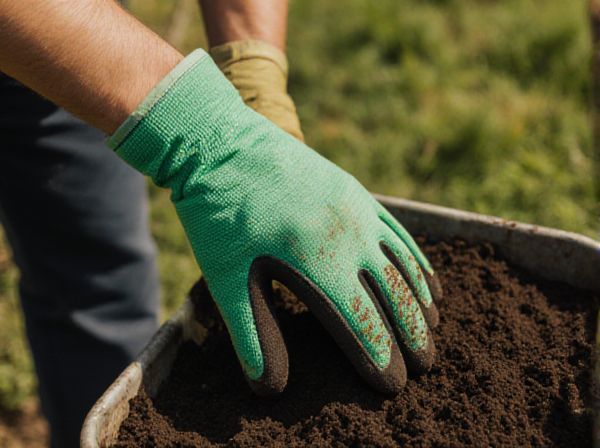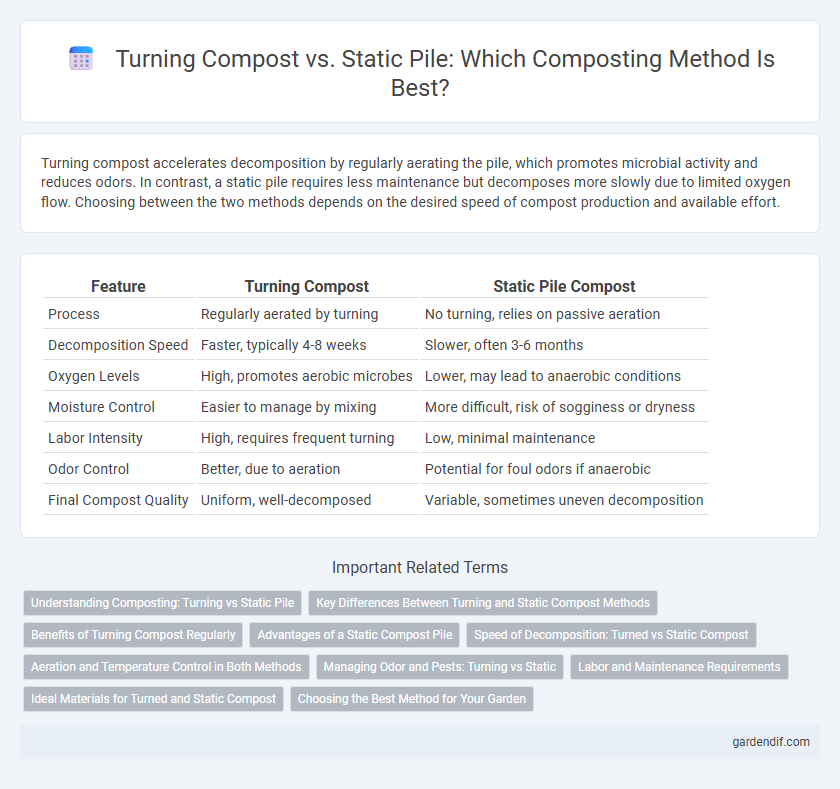
Turning compost vs Static pile Illustration
Turning compost accelerates decomposition by regularly aerating the pile, which promotes microbial activity and reduces odors. In contrast, a static pile requires less maintenance but decomposes more slowly due to limited oxygen flow. Choosing between the two methods depends on the desired speed of compost production and available effort.
Table of Comparison
| Feature | Turning Compost | Static Pile Compost |
|---|---|---|
| Process | Regularly aerated by turning | No turning, relies on passive aeration |
| Decomposition Speed | Faster, typically 4-8 weeks | Slower, often 3-6 months |
| Oxygen Levels | High, promotes aerobic microbes | Lower, may lead to anaerobic conditions |
| Moisture Control | Easier to manage by mixing | More difficult, risk of sogginess or dryness |
| Labor Intensity | High, requires frequent turning | Low, minimal maintenance |
| Odor Control | Better, due to aeration | Potential for foul odors if anaerobic |
| Final Compost Quality | Uniform, well-decomposed | Variable, sometimes uneven decomposition |
Understanding Composting: Turning vs Static Pile
Turning compost accelerates aerobic decomposition by introducing oxygen and distributing moisture, resulting in faster nutrient-rich humus formation compared to static piles. Static pile composting relies on microbial activity in a less disturbed environment, which can lead to slower breakdown but requires less labor and disturbance of microbial habitats. Optimal composting outcomes depend on balancing aeration, moisture, and microbial activity suited to either active turning or passive static pile management.
Key Differences Between Turning and Static Compost Methods
Turning compost involves regularly aerating the pile to accelerate decomposition by increasing oxygen flow and microbial activity, resulting in faster nutrient-rich humus. Static pile composting relies on passive decomposition with minimal disturbance, producing slower breakdown but requiring less labor and energy input. Key differences include decomposition speed, oxygen availability, and maintenance requirements, with turning promoting quicker results and static piles being more low-maintenance.
Benefits of Turning Compost Regularly
Turning compost regularly accelerates the decomposition process by increasing aeration and oxygen flow, which supports the growth of aerobic microorganisms essential for breaking down organic matter efficiently. This practice prevents the formation of anaerobic zones that can cause foul odors and slow down composting. Regular turning also helps maintain optimal moisture levels and temperature distribution, resulting in nutrient-rich compost ready for garden use faster than static piles.
Advantages of a Static Compost Pile
A static compost pile requires less labor and maintenance compared to turning compost, making it ideal for gardeners seeking a low-effort organic waste recycling method. It promotes consistent microbial activity and moisture retention by minimizing exposure to air disturbances, which enhances the natural decomposition process over time. Static piles also reduce the risk of nutrient loss and temperature fluctuations, resulting in nutrient-rich, stable compost suitable for improving soil fertility.
Speed of Decomposition: Turned vs Static Compost
Turning compost accelerates the speed of decomposition by increasing aeration, which promotes microbial activity and heat generation, typically reducing the composting process to 4-8 weeks. In contrast, static piles decompose more slowly, often taking several months, as limited oxygen availability slows microbial metabolism. Efficient oxygen flow in turned compost piles results in faster breakdown of organic material compared to the more anaerobic conditions in static piles.
Aeration and Temperature Control in Both Methods
Turning compost enhances aeration by regularly mixing organic materials, promoting oxygen flow essential for microbial activity and maintaining higher, more consistent temperatures. Static piles rely on passive aeration, which can lead to uneven oxygen distribution and cooler core temperatures, potentially slowing down decomposition. Proper temperature control in turned compost accelerates breakdown, while static piles require careful monitoring to prevent anaerobic conditions and ensure efficient composting.
Managing Odor and Pests: Turning vs Static
Turning compost piles enhances aeration, reducing anaerobic conditions that cause foul odors and discouraging pests by disrupting their habitat. Static piles, while requiring less labor, can develop anaerobic zones that produce unpleasant smells and attract pests if not carefully managed. Effective odor and pest control depend on maintaining proper moisture and carbon-to-nitrogen ratios regardless of the method chosen.
Labor and Maintenance Requirements
Turning compost requires regular labor to aerate and mix the pile, promoting faster decomposition and preventing odor issues. Static piles demand less frequent upkeep but may need intermittent moisture management and can experience slower breakdown rates. Overall, turning compost involves higher maintenance intensity, whereas static piles are lower-labor but may extend processing time.
Ideal Materials for Turned and Static Compost
Ideal materials for turned compost include a balanced mix of green nitrogen-rich items like grass clippings and kitchen scraps combined with brown carbon-rich materials such as dry leaves and wood chips to ensure proper aeration and faster decomposition. Static piles benefit from coarser materials like straw, shredded branches, and bulky yard waste that maintain airflow naturally, promoting slow, steady breakdown without frequent turning. Both methods require a proper carbon-to-nitrogen ratio, but turned composting favors finer, more homogeneous inputs while static piles tolerate larger, denser components.
Choosing the Best Method for Your Garden
Turning compost accelerates decomposition by increasing aeration and evenly distributing moisture, making it ideal for gardeners seeking faster nutrient-rich soil. Static piles require less labor and maintain moisture well but decompose more slowly due to limited oxygen exposure. Selecting between turning and static compost piles depends on garden size, time availability, and desired composting speed.
Turning compost vs Static pile Infographic

 gardendif.com
gardendif.com